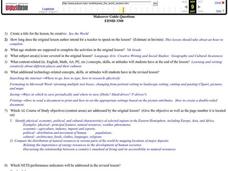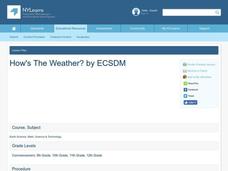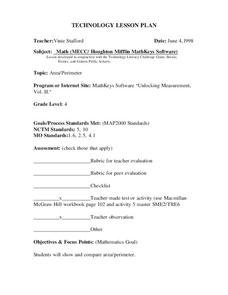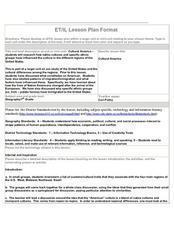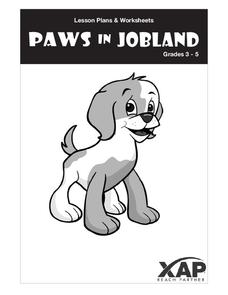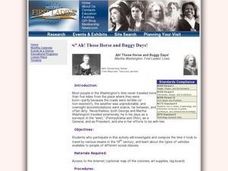Curated OER
Choosing a Family Dog
Fourth graders research types of dogs and recommend one that would make the best family pet. They work in cooperative groups of three using Kidspiration to map out the essential question before beginning their research, write reports,...
Curated OER
Alternative Energy
Students identify the five major alternative energy sources. In this physical science lesson, students assess the advantages and disadvantages for each type of energy. They complete a concept map using information they researched.
Curated OER
Anolis Lizards of the Greater Antilles
Students "take a trip" to the Greater Antilles to observethe Anolis lizards. They study the body structures and habitat of different species, then plot this data on a map to look for patterns in their distribution. From the patterns they...
Curated OER
Choose Your Own Soil Adventure
Ninth graders will use a soil survey to make management decisions and by interpreting geologic maps. The importance of different soil types is discussed and the implications of how soil can be useful for our communities.
Curated OER
See the World
Seventh graders locate and write creatively about different places and their cultures. They identify the physical, economic, social, political and cultural characteristics of selected regions in the Eastern Hemisphere. Finally, 7th...
Curated OER
The Reservations
Third graders investigate the concept of a reservation and how it effects the lives of Native American indian tribes. They conduct research with the help of guiding questions to find the correct type of information. Students take notes...
Curated OER
How's the Weather?
Students explore earth science by researching the Internet. In this weather pattern lesson, students utilize the website weather.com to analyze the weather in different geographic locations. Students view charts and graphs based on...
Curated OER
Native Americans - People of the Plains
Learners explore Plains Indians and practice computer skills by reading creation and migration stories on People of the Plains CD-ROM, and watching Plains video. Students examine village life of Plains Indians, and view different...
Curated OER
Wolf Pack in a Bottle
Students participate in an activity of a mock electrophoresis using paper chromatography to study DNA and genetic restriction mapping.
Curated OER
The Meatrix: Do You Want the Truth? Factory Farm vs. Family Farm
Students examine the differences between family farms and factory farms. They practice using different math computations and reading graphs and tables. They work together in groups to research the differences between the farms and make a...
Curated OER
The Arctic and Taiga Ecozone of Canada
Students discover the differences in the Arctic and Taiga regions of Canada. They identify physical and human characteristics of both region. They also practice using an atlas.
Curated OER
Area And Perimeter
Fourth graders investigate the concepts of area and perimeter, and they practice finding the values in various types of situations. They construct different representations of shapes using the area measurements and also explain the...
Curated OER
My Neighborhood: A Webquest
Students engage in a Webquest to discover their school and community. They interview staff members of the school, create maps and take digital photographs of the school. As they write about their school, they use Microsoft Word to...
Curated OER
Identifying trophic levels and the skeletal system through Owl Pellets
Students identify a food chain sequence. They compare, identify, and record the rodent skeletal parts to a rodent skeletal diagram. Students construct a rodent skeleton from the skeletal parts found in the pellet. They are given the...
Curated OER
Using Scholastic News to Introduce the Net
Third graders log on to the net, type in the address for Scholastic and browse the subjects for the week. They select one area of interest and generate five interesting facts about the article.
Curated OER
Cultural America
Seventh graders investigate the cultural differences that can be found in America. They discuss what it means to be called an American. The patterns of migration to America are discussed with the use of maps and geographical terms....
Curated OER
Stone Soup
Learners explain how various cultures affect the interactions that take place in a community. They compare and contrast families by where they live, the jobs they hold and the types of food they eat. Using examples, they sort goods and...
Curated OER
Plate Tectonics
Students simulate the three types of plate boundaries using robots. In this earth science lesson, students explain how earthquakes and volcanoes are formed. They collect real-world earthquake data and plot them on the map.
Curated OER
Yi Peoples--Sanctioning Taboo In China
Students identify the minority and ethnic groups in China. Using the internet, they discover the types of languages spoken and research the policies in place to manage minorities. In groups, they role-play the different ethnic groups...
Curated OER
Paws in Jobland
Young scholars explore jobs in different countries . In this lesson plan about different countries through research. Students are broken into groups and given a country to research. Each group is provided with a worksheet with 14...
Curated OER
Hyperlink Habitats
Students explore a series of Web pages designed to illustrate the interconnectedness of a tropical rainforest ecosystem. They discuss their research, create maps and research a local ecosystem.
Curated OER
Claim Your Jurisdiction Game
Students identify levels within the judicial system. They determine which court handles which particular type of case. Finally, they identify the differences between federal and state court jurisdiction.
Curated OER
And Your Point Is . . .? Part I
Students, in groups, complete a WebQuest titled "Love Canal Debate". They follow the WebQuest to research and write papers on different points of view regarding the Love Canal environmental disaster.
National First Ladies' Library
Ah! Those Horse and Buggy Days!
Students discuss contemporary methods of travel and the time it takes to travel to places. They use the Internet to explore 18th century travel. Students work in small group to research the amount of time it would have taken...




